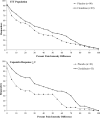Randomized control trial of topical clonidine for treatment of painful diabetic neuropathy
- PMID: 22683276
- PMCID: PMC3413770
- DOI: 10.1016/j.pain.2012.04.014
Randomized control trial of topical clonidine for treatment of painful diabetic neuropathy
Abstract
A length-dependent neuropathy with pain in the feet is a common complication of diabetes (painful diabetic neuropathy). It was hypothesized that pain may arise from sensitized-hyperactive cutaneous nociceptors, and that this abnormal signaling may be reduced by topical administration of the α(2)-adrenergic agonist, clonidine, to the painful area. This was a randomized, double-blind, placebo-controlled, parallel-group, multicenter trial. Nociceptor function was measured by determining the painfulness of 0.1% topical capsaicin applied to the pretibial area of each subject for 30minutes during screening. Subjects were then randomized to receive 0.1% topical clonidine gel (n=89) or placebo gel (n=90) applied 3 times a day to their feet for 12weeks. The difference in foot pain at week 12 in relation to baseline, rated on a 0-10 numerical pain rating scale (NPRS), was compared between groups. Baseline NPRS was imputed for missing data for subjects who terminated the study early. The subjects treated with clonidine showed a trend toward decreased foot pain compared to the placebo-treated group (the primary endpoint; P=0.07). In subjects who felt any level of pain to capsaicin, clonidine was superior to placebo (P<0.05). In subjects with a capsaicin pain rating ⩾2 (0-10, NPRS), the mean decrease in foot pain was 2.6 for active compared to 1.4 for placebo (P=0.01). Topical clonidine gel significantly reduces the level of foot pain in painful diabetic neuropathy subjects with functional (and possibly sensitized) nociceptors in the affected skin as revealed by testing with topical capsaicin. Screening for cutaneous nociceptor function may help distinguish candidates for topical therapy for neuropathic pain.
Copyright © 2012 International Association for the Study of Pain. Published by Elsevier B.V. All rights reserved.
Figures






Comment in
-
Tailored treatment of peripheral neuropathic pain.Pain. 2012 Sep;153(9):1781-1782. doi: 10.1016/j.pain.2012.06.002. Epub 2012 Jun 22. Pain. 2012. PMID: 22727536 No abstract available.
References
-
- Ali Z, Ringkamp M, Hartke TV, Chien HF, Flavahan NA, Campbell JN, Meyer RA. Uninjured C-fiber nociceptors develop spontaneous activity and alpha-adrenergic sensitivity following L6 spinal nerve ligation in monkey. J Neurophysiol. 1999;81:455–466. - PubMed
-
- Campbell JN. Nerve lesions and the generation of pain. Muscle Nerve. 2001;24:1261–1273. - PubMed
-
- Cleeland CS, Ryan KM. Pain assessment: global use of the Brief Pain Inventory. Ann Acad Med Singapore. 1994;23:129–138. - PubMed
-
- Davis KD, Treede RD, Raja SN, Meyer RA, Campbell JN. Topical application of clonidine relieves hyperalgesia in patients with sympathetically maintained pain. Pain. 1991;47:309–317. - PubMed
Publication types
MeSH terms
Substances
Grants and funding
LinkOut - more resources
Full Text Sources
Other Literature Sources
Medical

